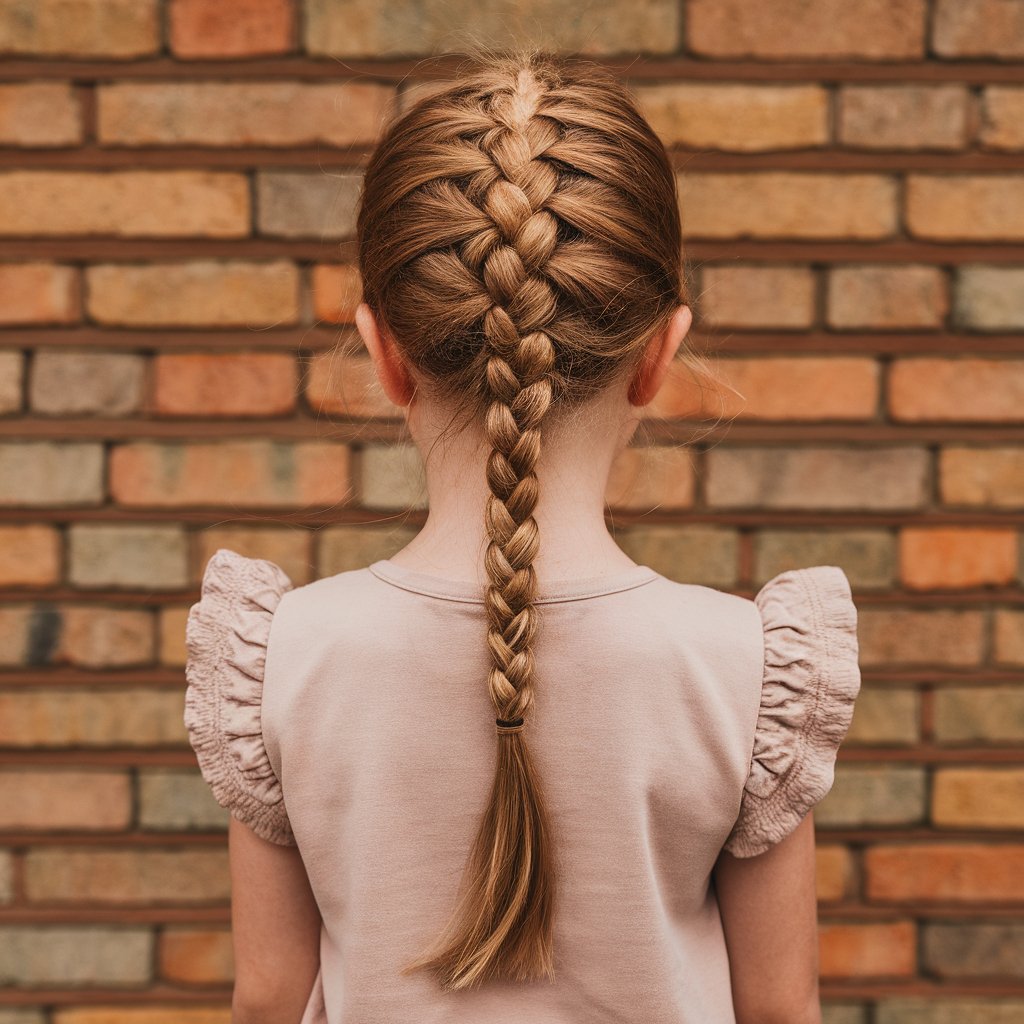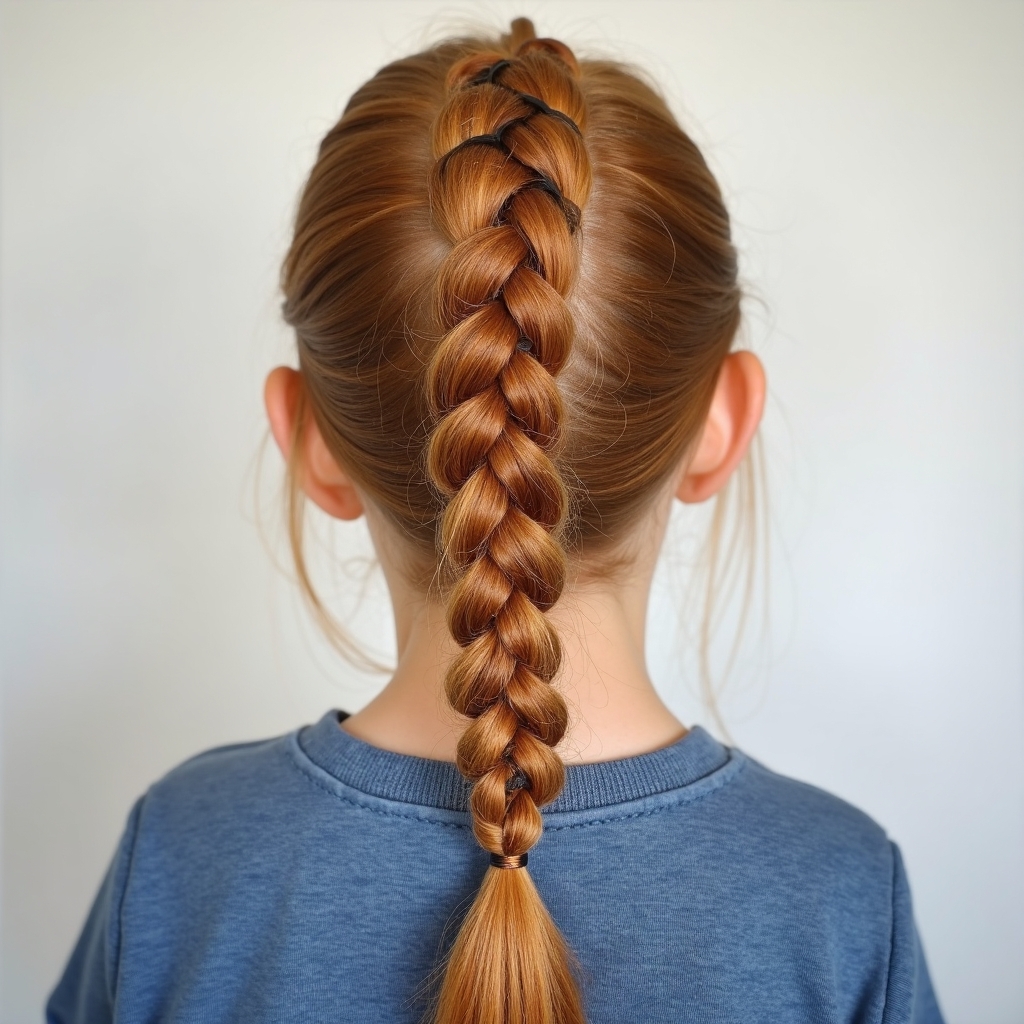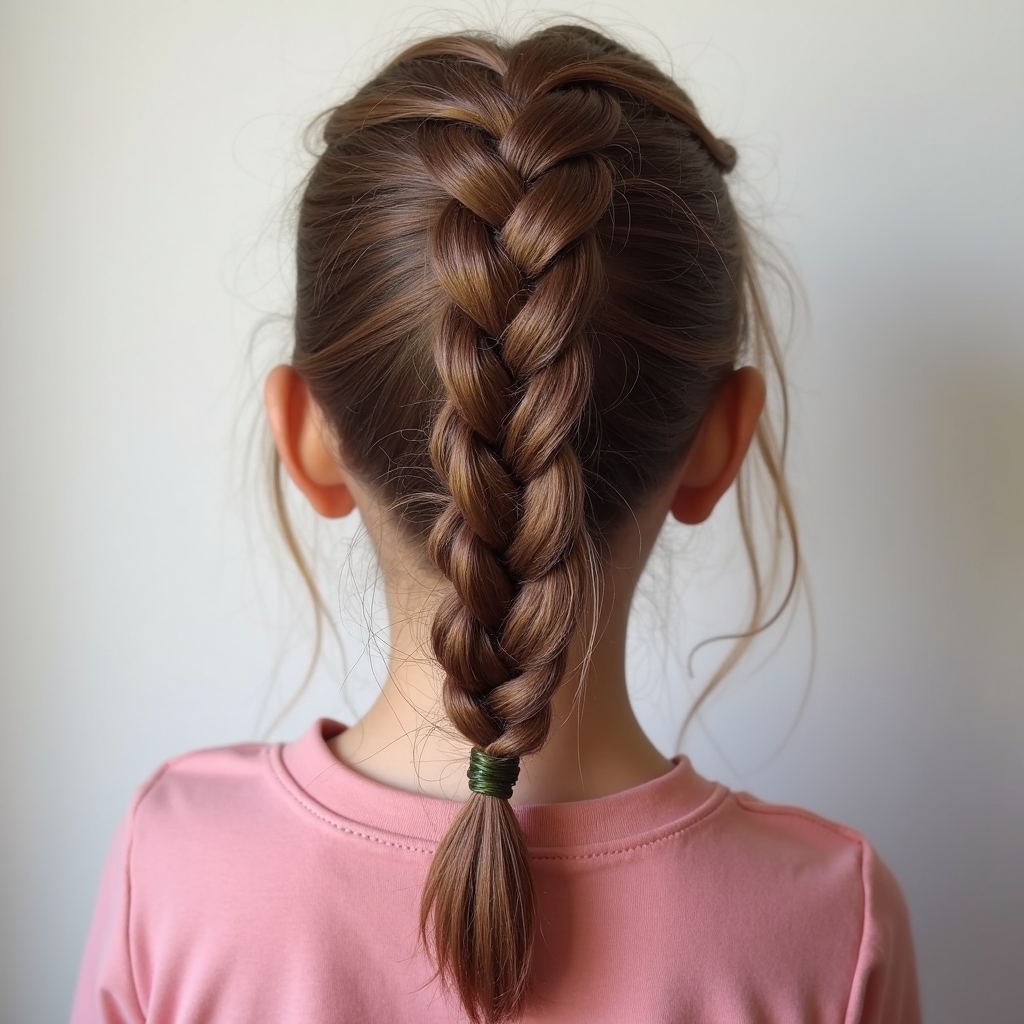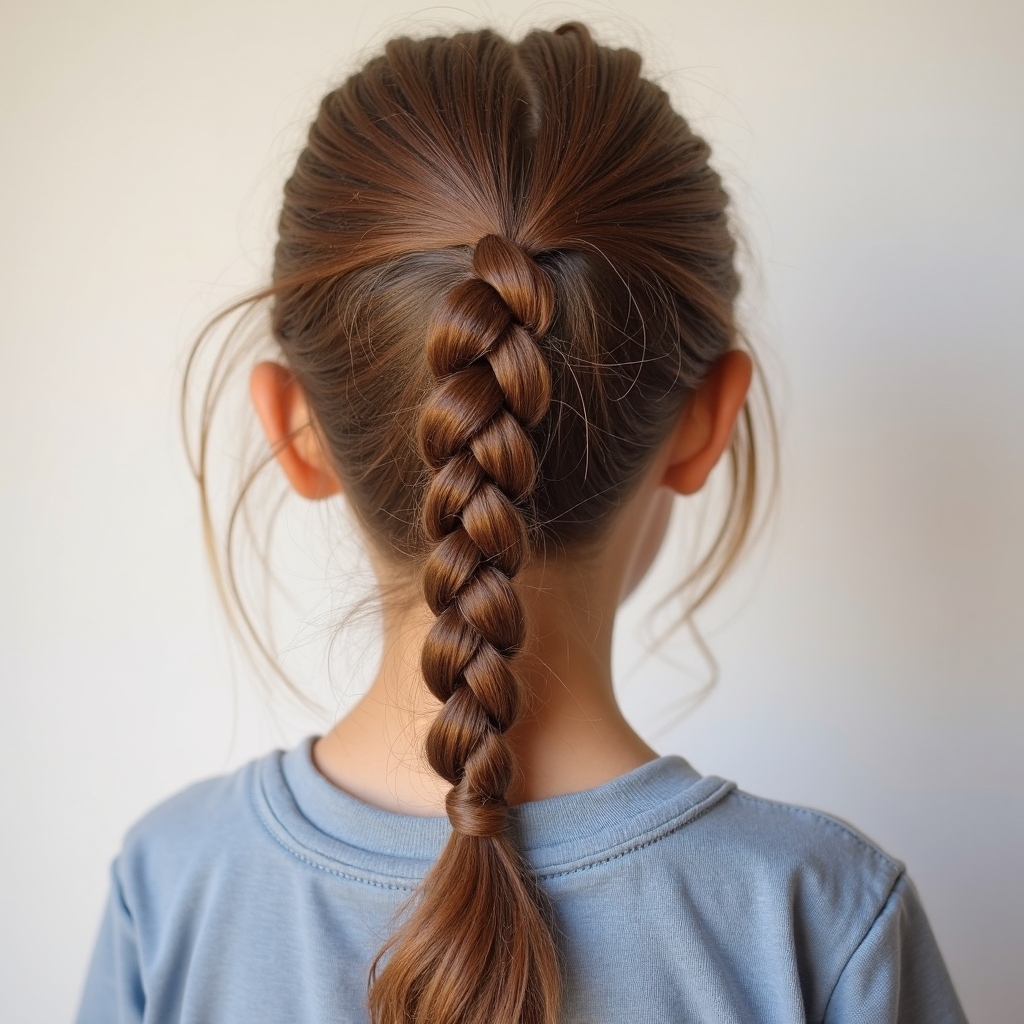Dutch braids are a charming hairstyle that’s gaining popularity among parents looking for cute and practical options for their children. These braids, also known as reverse French braids or inside-out braids, create a raised, rope-like pattern that sits close to the scalp. They offer a stylish and secure way to keep kids’ hair tidy throughout their active days.
For little ones, Dutch braids are an excellent choice. They keep hair out of the face during playtime and school activities, reducing distractions and the need for constant adjustments. This particular style is also versatile, suitable for various hair types and lengths, making it a go-to option for many parents seeking a reliable hairstyle for their children.
The benefits of Dutch braids for kids’ hair extend beyond their visual appeal. These braids can help protect delicate strands from damage caused by daily wear and tear. They also promote healthy hair growth by minimizing tangling and breakage. In the following sections, we’ll explore the unique features of Dutch braids, provide a step-by-step guide for creating them, and share tips for making them last longer on active kids. Keep reading to discover how to master this adorable and practical hairstyle for your little ones.
- What makes Dutch braids different from other braids?
- How to create basic Dutch braids for kids
- What are some adorable Dutch braid styles for little ones?
- How can you make Dutch braids last longer on active kids?
- What are common challenges when Dutch braiding kids' hair?
- Mastering the Art of Dutch Braids for Your Little Ones
- Frequently Asked Questions
What makes Dutch braids different from other braids?

Dutch braids have gained popularity as a stylish and practical hairstyle for kids. But what sets them apart from other braiding techniques? Let’s explore the distinctive features that make Dutch braids a favorite among parents and children alike.
Dutch vs. French braids: Key differences
At first glance, Dutch and French braids might look similar, but they have one crucial difference. In a Dutch braid, you cross the hair strands under the middle section, while in a French braid, you cross them over. This simple change in technique creates a completely different look.
The result? Dutch braids appear to sit on top of the hair, creating a raised, rope-like pattern. French braids, on the other hand, blend more seamlessly into the hair, giving a flatter appearance. This distinction makes Dutch braids stand out more prominently, adding a touch of flair to any hairstyle.
Unique characteristics of Dutch braids
What makes Dutch braids so special? Here are some of their standout features:
- Texture: They create a more pronounced, three-dimensional look
- Direction: The braid appears to be inverted or inside-out
- Visibility: The braiding pattern is more noticeable and defined
- Adaptability: They work well with various hair accessories and styles
These characteristics contribute to the eye-catching nature of Dutch braids, making them a fun and visually interesting choice for kids’ hairstyles.
How Dutch braids sit on the head
The way Dutch braids are positioned on the head is another factor that sets them apart. Due to the under-crossing technique used in their creation, these braids sit closer to the scalp compared to other styles. This close-to-the-head placement offers several advantages for active children.
Firstly, it keeps hair securely in place during physical activities. Secondly, it helps distribute the weight of the hair more evenly, reducing strain on the scalp. Lastly, this positioning allows for a neater appearance that lasts longer throughout the day.
Versatility of Dutch braids for various hair types
One of the great things about Dutch braids is their suitability for different hair textures and lengths. Whether your child has fine, thick, curly, or straight hair, this braiding technique can be adapted to work well.
For fine hair, Dutch braids can create the illusion of fuller, more voluminous locks. They also work wonders for thick hair, helping to control and manage abundant tresses. Curly-haired kids can benefit from the frizz-reducing properties of Dutch braids, while those with straight hair can enjoy added texture and interest.
Why Dutch braids stay in place longer
Have you ever wondered why Dutch braids seem to hold up better than other styles? The secret lies in their structure. The under-crossing technique creates more friction between the hair strands, resulting in a tighter, more secure braid.
This increased stability means Dutch braids are less likely to unravel or come loose during your child’s daily activities. They can withstand the rigors of playtime, sports, and even naps, maintaining their neat appearance for longer periods.
Additionally, the close-to-scalp positioning of Dutch braids contributes to their longevity. With less hair hanging loose, there’s less opportunity for tangles and knots to form throughout the day.
Dutch braids offer a winning combination of style and practicality for kids’ hair. Their unique structure, versatility, and staying power make them an excellent choice for parents looking for a hairstyle that can keep up with their children’s active lifestyles.
How to create basic Dutch braids for kids

Creating Dutch braids for kids can be a fun and rewarding experience. This hairstyle not only looks adorable but also keeps hair tidy and manageable throughout the day. Let’s explore how to master this technique and create beautiful Dutch braids for your little ones.
Essential tools for Dutch braiding
Before you start, gather the necessary items for a smooth braiding process. You’ll need:
- A hairbrush to detangle and smooth the hair
- Hair ties to secure the finished braid
- Hair clips for sectioning
- A comb for precise parting
- Leave-in conditioner or braid spray to manage frizz
Having these tools at hand will make the braiding process much easier and more efficient.
Preparing the hair: Brushing and sectioning
Proper preparation is key to achieving a neat and long-lasting Dutch braid. Start by thoroughly brushing the hair to remove any knots or tangles. This step is crucial for creating a smooth braid and preventing discomfort for your child during the process.
Next, decide on the parting style. You can opt for a middle part or a side part, depending on your preference or your child’s usual style. Use a comb to create a clean, straight part.
Now, it’s time to section the hair. Divide it into three main sections: one for the braid and one on each side. Use hair clips to keep these sections separate and manageable. This organization will make the braiding process much smoother.
A helpful tip: Apply a small amount of leave-in conditioner or braid spray to the hair. This will help control frizz and make the hair easier to work with as you braid.
Step-by-step guide to Dutch braiding
Now that the hair is prepped, let’s dive into the braiding process:
- Begin with the hair parted and sectioned as desired.
- Take the right section and cross it under the middle section.
- Next, take the left section and cross it under the current middle section.
- As you continue, add hair from the sides to each section before crossing it under.
- Repeat this process, working your way down the head.
Remember, the key difference between Dutch and French braids is that you’re crossing the sections under rather than over. This creates the distinctive raised look of a Dutch braid.
Tips for keeping the braid tight and neat
Creating a tight and neat braid can be challenging, especially when working with kids’ hair. Here are some strategies to help:
Hold the hair taut as you braid. This helps maintain tension and keeps the braid tight. Work section by section, avoiding tangles and maintaining control. If you notice any flyaways, use a little spray or gel to smooth them down.
A useful trick is to use a comb to refine each section as you create the braid. This can help you achieve a cleaner, more polished look. Practice using gentle but firm hand movements to avoid loosening the braid prematurely.
Securing the braid: Best hair ties for kids
Choosing the right hair tie is crucial for keeping the braid intact and comfortable for your child. Soft, fabric-covered elastic bands are gentle on hair and minimize breakage. Spiral hair ties are another excellent option as they help prevent tangles and are less likely to slip.
For thicker hair, consider cloth hair ties with a stronger grip. They provide better hold without causing damage. Clear rubber bands can be used for a discreet look, but be careful when removing them to avoid tugging on the hair.
An innovative option to try is the ceiling-style hair bungee. This type of tie secures braids without causing damage and can be especially useful for active kids.
By following these steps and tips, you’ll be well on your way to creating beautiful Dutch braids for your children. With practice, you’ll find the process becoming easier and quicker, allowing you to experiment with different styles and variations of this versatile hairstyle.
What are some adorable Dutch braid styles for little ones?

Dutch braids offer a world of possibilities for creating charming hairstyles for little ones. These versatile braids can be styled in numerous ways, allowing you to switch up your child’s look while maintaining the practicality and neatness of the style. Let’s explore some adorable Dutch braid styles that are perfect for kids.
Double Dutch pigtails: A classic look
One of the most popular styles for children is the double Dutch pigtail. This timeless look involves creating two separate Dutch braids, one on each side of the head. To achieve this style, part the hair down the middle and secure each section. Then, create a Dutch braid on each side, starting from the hairline and working your way down to the nape of the neck.
The result is a symmetrical, polished appearance that keeps hair neatly in place throughout the day. This style works well for school, playdates, or any casual occasion. It’s particularly suitable for active children as it keeps hair out of the face during physical activities.
Half-up Dutch crown braid
For a more whimsical look, try the half-up Dutch crown braid. This style combines the elegance of a crown braid with the practicality of leaving some hair loose. Begin by sectioning off the top portion of the hair, from ear to ear across the crown of the head. Create a Dutch braid with this section, working from one side to the other.
As you braid, incorporate hair from the loose sections on either side. Once you reach the opposite ear, secure the braid with a hair tie. The remaining hair can be left loose or styled as desired. This look is perfect for special events or days when you want to add a touch of sophistication to your child’s appearance.
Dutch braid headband
The Dutch braid headband is a creative way to keep bangs or shorter layers out of your child’s face. Start by creating a small Dutch braid along the hairline, working from one side of the head to the other. The braid should follow the natural curve of the head, creating a headband-like effect.
Here are some tips for perfecting this style:
- Use a fine-toothed comb to create a clean part
- Apply a small amount of styling product to tame flyaways
- Secure the end of the braid behind the ear with bobby pins
This style works well for both long and short hair, making it a versatile option for various hair lengths and textures.
Spiral Dutch braid
For a fun and eye-catching style, consider the spiral Dutch braid. This technique creates a swirled pattern that starts at the crown and spirals down to the nape of the neck. Begin by sectioning off a small portion of hair at the crown. Start your Dutch braid here, and as you work, move in a circular motion around the head.
Continue adding hair to the braid as you go, following the spiral pattern until you reach the nape of the neck. This style may take some practice to master, but the result is a stunning, intricate look that’s sure to turn heads. It’s an excellent choice for parties or special events where you want your child’s hairstyle to stand out.
Dutch braid bun for special occasions
For formal events or special occasions, the Dutch braid bun offers an elegant and sophisticated option. Start by creating a Dutch braid from the hairline to the nape of the neck. Once you’ve braided all the hair, gently tug on the edges of the braid to loosen it slightly. This creates a fuller, more textured appearance.
Next, carefully wrap the braid around itself to form a bun at the nape of the neck. Secure the bun with bobby pins, tucking in any loose ends. For added security, you can use a hair tie around the base of the bun. This style works particularly well for children with longer hair and can be adorned with hair accessories for extra flair.
Each of these styles offers a different way to showcase the beauty of Dutch braids. They range from simple everyday looks to more intricate styles for special occasions. By mastering these techniques, you’ll have a variety of options to keep your child’s hair looking neat, stylish, and age-appropriate.
Remember, patience is key when trying new hairstyles. It may take a few attempts to perfect each technique, but with practice, you’ll soon be creating beautiful Dutch braid styles for your little one with ease.
How can you make Dutch braids last longer on active kids?

Keeping Dutch braids intact on active kids can be a challenge. However, with the right techniques and products, you can extend the life of these hairstyles, saving time and effort in your daily routine. Let’s explore some effective strategies to make Dutch braids last longer on your little ones.
Choosing the right hair products for longevity
The foundation of long-lasting Dutch braids starts with the products you use. Opt for a lightweight leave-in conditioner to moisturize the hair and reduce friction between strands. This helps prevent frizz and keeps the braid looking neat for a longer period.
A good quality hair gel or styling cream can also work wonders. Apply a small amount to the hair before braiding to help smooth flyaways and keep the style in place. Be cautious not to use too much product, as this can make the hair look greasy or weigh it down.
For extra hold, consider using a light-hold hairspray after completing the braid. Spray it lightly over the finished style to set it in place without making the hair stiff or crunchy.
Techniques to prevent frizz and flyaways
Frizz and flyaways can quickly make a neat Dutch braid look messy. To combat this, try these techniques:
- Use a boar bristle brush to smooth the hair before braiding
- Braid the hair when it’s slightly damp for better control
- Apply a small amount of anti-frizz serum to the hair ends
- Use your fingers to gently smooth any loose hairs as you braid
Another helpful tip is to braid the hair more tightly than you think necessary. As kids play and move throughout the day, the braid will naturally loosen a bit. Starting with a tighter braid helps it maintain its shape for longer.
Nighttime care for preserving Dutch braids
Proper nighttime care can significantly extend the life of Dutch braids. Start by covering your child’s head with a silk or satin bonnet or scarf before bed. This reduces friction between the hair and the pillowcase, preventing frizz and keeping the braid intact.
If your child finds a bonnet uncomfortable, consider switching to a silk or satin pillowcase instead. This provides similar benefits without requiring anything to be worn on the head.
For added protection, you can gently wrap the braid in a spiral around the head and secure it with bobby pins. This “crown” style keeps the braid from getting squished or tangled during sleep.
Refreshing Dutch braids without starting over
Even with the best care, Dutch braids may start to look a bit disheveled after a day or two. However, you don’t always need to start from scratch. Here’s a quick method to refresh the style:
- Gently loosen any tight areas of the braid with your fingers.
- Smooth any frizzy sections with a small amount of leave-in conditioner or styling cream.
- Re-braid any loose sections, incorporating them back into the main braid.
- Secure any new loose ends with small clear elastic bands.
This touch-up process can often extend the life of the braid by an extra day or two, saving you time in your morning routine.
When to take out the braids: Signs to watch for
While Dutch braids can last for several days, it’s important to know when it’s time to take them out. Pay attention to these signs:
The scalp becomes itchy or irritated: This could indicate that it’s time to wash the hair and give the scalp a break.
The braid is very loose or messy: If more than half of the hair has come out of the braid, it’s probably easier to start over than to try and fix it.
You notice tangling at the nape of the neck: This area is prone to tangling in braided styles and may need to be addressed to prevent knots from forming.
The hair starts to smell: Even with good care, oils and sweat can accumulate over time. If you notice an odor, it’s time for a wash.
By paying attention to these signs, you can maintain healthy hair while maximizing the lifespan of your child’s Dutch braids. Remember, every child’s hair is different, so what works for one may not work for another. Don’t be afraid to experiment with different products and techniques to find the best method for your little one’s hair type and lifestyle.
What are common challenges when Dutch braiding kids’ hair?

Dutch braiding kids’ hair can be a rewarding experience, but it often comes with its own set of challenges. From squirmy children to tricky hair textures, parents and caregivers may encounter various obstacles. Let’s explore some common issues and practical solutions to make the braiding process smoother and more enjoyable for both you and your little one.
Dealing with wiggly children during braiding
One of the most frequent hurdles in creating Dutch braids for kids is their tendency to fidget and move around. How can you keep your child still long enough to complete the style? Try these strategies:
- Make braiding time fun with stories or songs
- Use a special “braiding chair” to signal it’s time to sit still
- Offer a small reward for good behavior during styling
Another effective approach is to break the braiding process into shorter sessions. For instance, you could section the hair one day and complete the braid the next. This method can be particularly helpful for younger children with shorter attention spans.
Adapting Dutch braids for different hair textures
Kids’ hair comes in a wide variety of textures, each presenting its own challenges for Dutch braiding. Curly hair may be prone to tangling, while straight hair might slip out of the braid easily. How can you adapt your technique for different hair types?
For curly hair, start by detangling thoroughly with a wide-toothed comb. Consider using a leave-in conditioner to reduce friction and make the hair more manageable. When braiding, maintain consistent tension to keep the style neat.
Straight hair often benefits from a bit of texturizing spray before braiding. This adds grip and helps prevent the hair from slipping out of the braid. You might also find that braiding the hair when it’s slightly damp improves your control and the longevity of the style.
Managing fine or slippery hair
Fine or slippery hair can be particularly challenging for Dutch braids, as it tends to slide out of place easily. How can you create a lasting braid with this hair type?
- Start with clean, dry hair to maximize grip.
- Apply a light styling mousse or texturizing powder to add hold.
- Section the hair more finely than you would with thicker hair.
- Braid with slightly more tension than usual, but be careful not to pull too tight.
- Secure each section with small, clear elastic bands as you go.
These techniques can help you achieve a neat, long-lasting Dutch braid even on the finest hair.
Incorporating accessories into Dutch braids
Adding accessories to Dutch braids can elevate the style, but it also presents its own set of challenges. How can you incorporate hair clips, ribbons, or other decorations without disrupting the braid?
One effective method is to plan your accessory placement before you start braiding. You can leave small sections of hair out as you braid, then use these to secure accessories once the braid is complete. For ribbon braids, start by attaching the ribbon to the hair at the beginning of the braid, then incorporate it as you go.
Remember that less is often more with accessories. Too many decorations can overwhelm the braid and make it more likely to come loose. Choose one or two key pieces that complement the overall style.
Troubleshooting uneven or loose braids
Even experienced braiders sometimes end up with uneven or loose results. What can you do if your Dutch braid doesn’t turn out as expected?
If the braid is uneven, try gently tugging on the smaller sections to even out the braid’s thickness. For loose braids, you can often salvage the style by carefully re-braiding small sections and securing them with bobby pins.
Prevention is key for avoiding these issues. Here are some tips to help you achieve a more consistent braid:
- Start with evenly sized sections of hair
- Maintain consistent tension throughout the braiding process
- Add hair to each section in similar amounts as you braid
- Use your fingers to smooth and tighten the braid as you go
With practice, you’ll develop a feel for the right tension and technique to create even, secure Dutch braids every time.
Mastering Dutch braids for kids takes patience and practice. Each child’s hair is different, so don’t be discouraged if you need to adjust your approach. By understanding these common challenges and implementing these strategies, you’ll be better equipped to create beautiful, lasting Dutch braids for your little ones.
Mastering the Art of Dutch Braids for Your Little Ones
Dutch braids offer a versatile and practical hairstyle option for children, combining both style and functionality. From classic double pigtails to more intricate styles like the spiral Dutch braid, these hairstyles can suit various occasions and hair types. By understanding the unique characteristics of Dutch braids and mastering the techniques to create them, you can provide your child with a hairstyle that not only looks adorable but also stays put throughout their active day.
As with any skill, creating perfect Dutch braids takes practice and patience. Don’t be discouraged by initial challenges such as dealing with wiggly children or managing different hair textures. With time, you’ll develop strategies to overcome these hurdles and find what works best for your child’s hair. Remember to use appropriate products, adapt your technique to your child’s hair type, and maintain the braids properly to extend their lifespan. By doing so, you’ll be able to create beautiful, long-lasting Dutch braids that both you and your little one will love.
Frequently Asked Questions
Q: What makes Dutch braids different from French braids?
A: Dutch braids cross hair strands under the middle section, while French braids cross them over, resulting in a raised, rope-like pattern for Dutch braids.
Q: How can I keep my child still during the braiding process?
A: Try making braiding time fun with stories or songs, use a special “braiding chair,” or offer a small reward for good behavior during styling.
Q: What products should I use to make Dutch braids last longer?
A: Use a lightweight leave-in conditioner, a small amount of hair gel or styling cream, and a light-hold hairspray to help the braid stay neat and in place.
Q: How can I adapt Dutch braids for curly hair?
A: Start by thoroughly detangling with a wide-toothed comb, use a leave-in conditioner to reduce friction, and maintain consistent tension while braiding.
Q: What’s the best way to preserve Dutch braids overnight?
A: Cover your child’s head with a silk or satin bonnet or scarf, or use a silk or satin pillowcase to reduce friction and prevent frizz.
Q: How do I manage fine or slippery hair when Dutch braiding?
A: Start with clean, dry hair, apply a light styling mousse or texturizing powder, section the hair more finely, and braid with slightly more tension than usual.
Q: When should I take out my child’s Dutch braids?
A: Remove the braids if you notice scalp irritation, excessive looseness or messiness, tangling at the nape of the neck, or if the hair starts to smell.
Q: How can I incorporate accessories into Dutch braids?
A: Plan accessory placement before braiding, leave small sections of hair out to secure accessories later, or attach ribbons at the beginning of the braid and incorporate them as you go.

